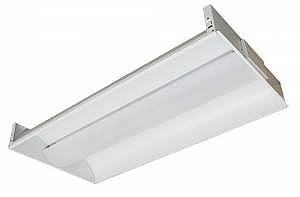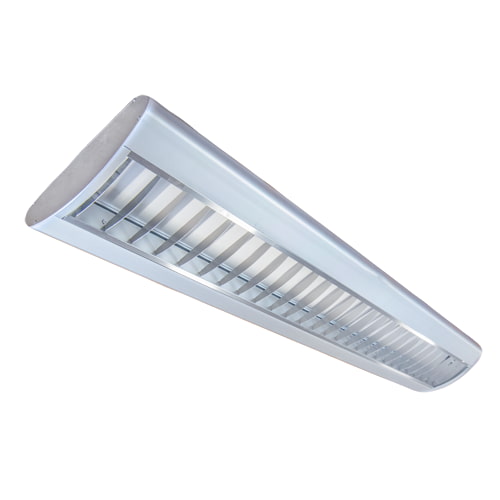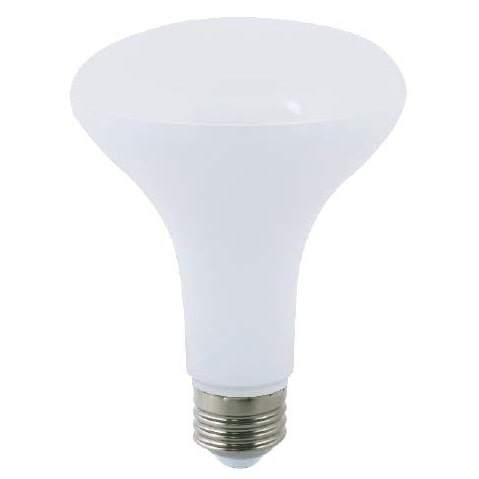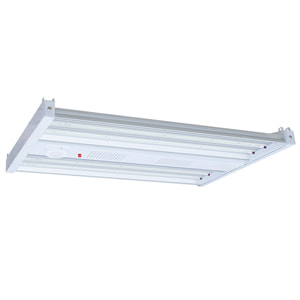Office Lighting
Commercial Office Lighting Fixtures & Bulbs
In today’s commercial office buildings, reducing maintenance and saving cost while ensuring proper illumination throughout your facility is paramount. We sell a variety of commercial quality office lighting fixtures for ceilings of any height. Our experts work with electrical contractors, project managers, and building owners to design lighting layouts that maximize lighting quality while maintaining budget friendly pricing and cost.
LED Lighting For Commercial Offices

Commercial office spaces are vital for businesses throughout the world to house a multitude of professional staff. Often quite large in scale, these offices have significant lighting demands that make up a sizable amount of a company’s annual operating budget. Choosing the right lighting setup can make a big difference not only from a pure operating cost standpoint, but it also can have a noticeable effect on employee efficiency and job satisfaction.
In recent years, revolutions in LED lighting technology have resulted in huge improvements in office and indoor commercial lighting. In fact, LED lights are now the dominant form of lighting for this application, being used in both new installs as well as retrofitting. These lights provide a far better quality of light than traditional lighting technologies such as fluorescents and incandescents, with higher accuracy as well as being easier on the eyes. They are also significantly more energy efficient, oftentimes saving users upwards of 70% in electricity costs.
Before and After
The office building was originally using T8 fluorescent bulbs in their Troffer Lighting Fixtures. These bulbs were replaced with 15 watt X-Series LED T8 tubes which are direct replacements for 32-watt fluorescents. As you can see in the images below, switching to LEDs increased the overall brightness within the office space as well as saved significant costs for their business.
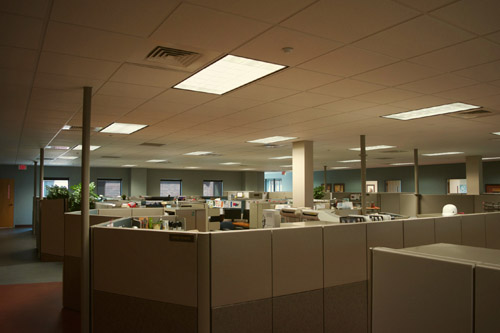
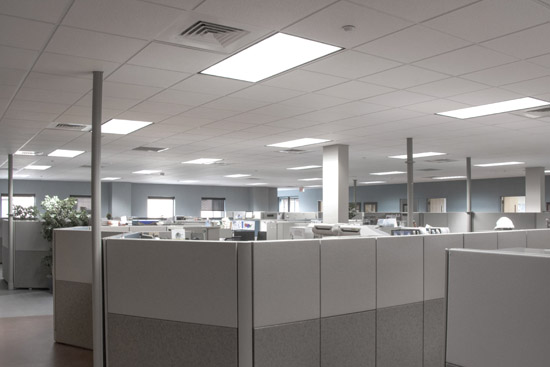
Current Annual Lighting Cost
LED Annual Lighting Cost
LED Retrofit Cost
Annual Savings with LED
Financial Summary
Environmental Impact
Office Lighting Layout Design
Like any other lighting setup, office lighting must be properly configured with a layout designed to both maximize efficiency as well as provide appropriate light output and coverage for an area. The first step in determining the lighting design has to do with measuring the ceiling height in the area to be illuminated. This will determine the required lumen output of the fixture, as well as the appropriate beam angle to provide good coverage.
Once the height is determined, other factors such as room dimensions come into play. Not only is total square footage important, but also the specific dimensions - especially in rooms with irregular shapes outside of basic square and rectangular configurations. This will determine the quantity of fixtures as well as their placement within a room. In certain situations it may involve the use of multiple different types of fixtures in order to provide proper coverage.
Because of the wide variance in these factors and the way in which they interact with each other, it takes significant planning and calculation in order to properly set up. Recognizing the importance of this, we offer professional photometric planning in order to ensure the most efficient and cost effective solution for each specific application.
To better illustrate this, below is an example of a commercial office space lighting project our photometric experts created for a corporate building manager. This plan is designed for a 15' x 20' (300 square foot) office with a 10 foot high ceiling.
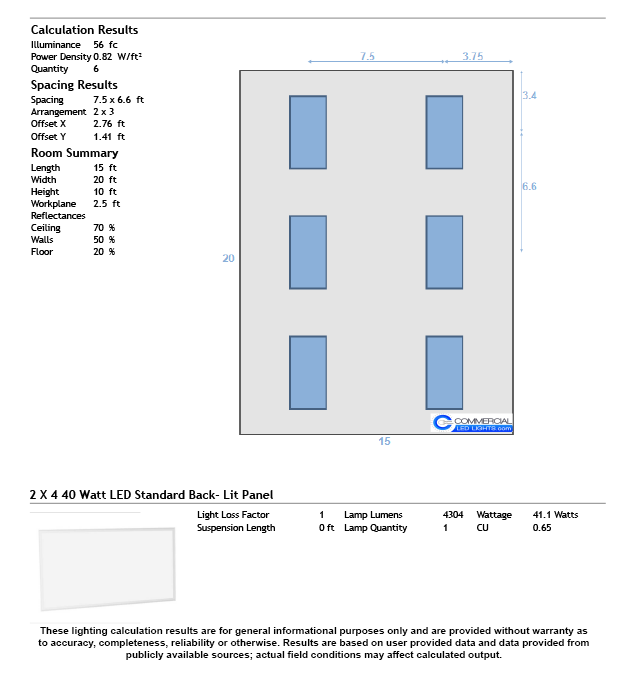
This plan provides not only details such as the recommended number of fixtures, but also shows the recommended foot candles, total lumen output, total wattage, etc.
Commercial Office Lighting By Location
General Office Rooms - These are typically large general purpose areas used for offices and cubicles. For these areas, troffers and flat panel lights are the most popular due to the ceiling configurations normally seen in these areas. These types of fixtures produce solid light output while seamlessly integrating into these ceiling setups, making them a good choice for offices, especially at large scale.
Server Rooms - As these rooms are rarely used aside from the occasional checking of servers and general maintenance, their lighting requirements are usually less stringent than most areas within an office building. In these areas, suspended ceiling lighting and strip lights are the most common type of fixture used, as well as troffers if the room already has an existing drop ceiling.
Stairway - Strip and shop lights are by far the most popular for stairways, due to their high lumen output for their size. For outdoor staircases, vapor tight and canopy lights are the most popular choice, due to their solid weather resistance and sturdy construction.
Storage & Utility Rooms - As these rooms have the least stringent lighting requirements, they are a lot more flexible in the type of light fixture used. Generally speaking, simple strip and shop lights are the go-to option for these rooms, as they are not required to have weather resistance or have exceptionally high lumen output.
Hallways and Corridors - Since most ceilings in office hallways and corridors are either of the drop ceiling or drywall type, troffers and flat panel lights are the most popular. Troffers are designed exclusively to work with drop ceiling systems, whereas flat panels can be used either in drop ceilings or attached directly to finished ceilings, depending on users interior design preferences.
Reception Area - Since reception areas are usually the first impression for guests, it is important that these areas have high quality lighting. Practically every type of reception area will have finished ceilings, which narrows down the lighting fixture options. Depending on the configuration of the reception area, they typically will have troffers, recessed lights or flat panel lighting.
Conference Room - Drop ceilings are by far the most common configuration seen in conference rooms, and therefore they will be using either troffer lights, flat panels or some combination of the two. While troffers are specifically designed for use in drop ceilings, flat panels give the option of using in either drop ceilings or attached directly to a finished ceiling - allowing for flexibility in interior design.

Break Room - Since these areas are typically a more relaxed atmosphere, their lighting requirements are less stringent. These areas normally use either drop ceiling style lights or suspended lighting, depending on how the interior of the building is configured. In this specific type of application, energy efficiency is the most important factor.
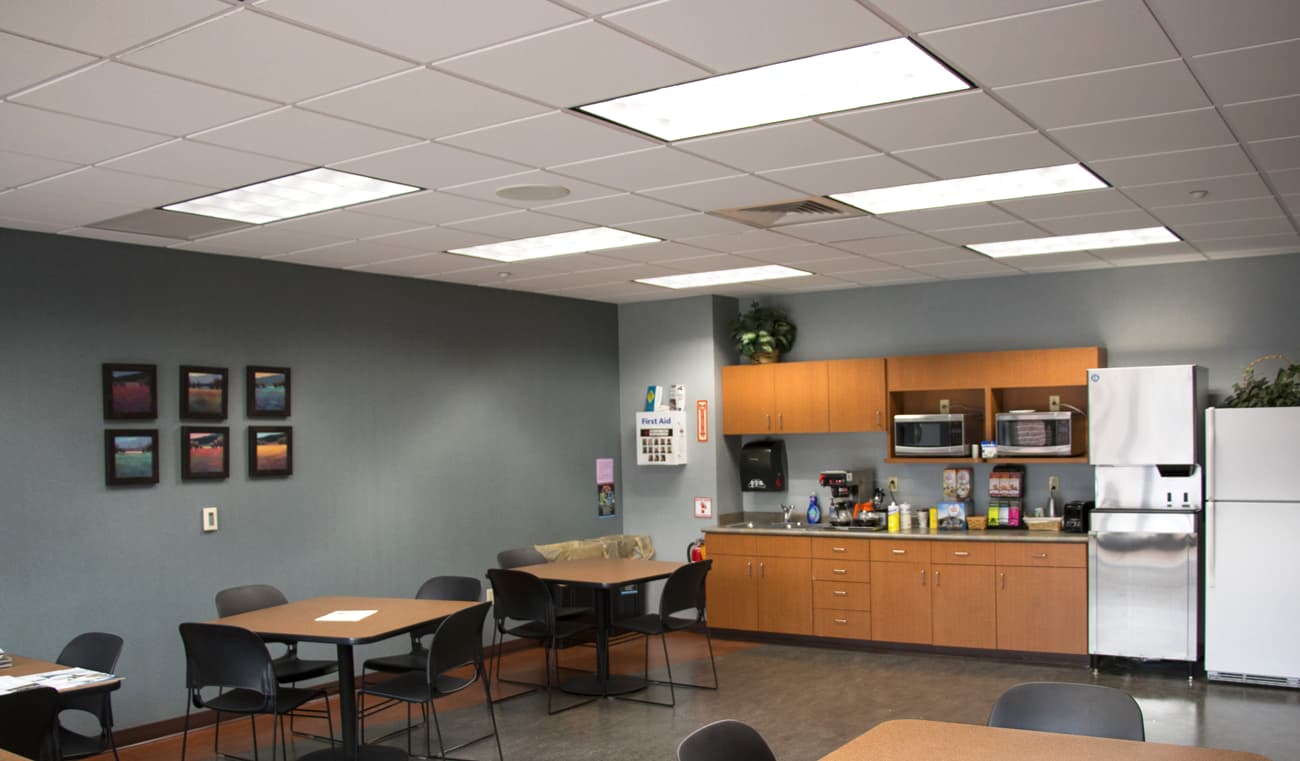
Types of Office Lighting Fixtures/Bulbs
There are several types of lights ideally suited for commercial office spaces. The fixture type used will largely depend on the interior design of the room, with some applications even being able to upgrade their existing fixtures to LED technology instead of replacing the fixture entirely. Below are the most common LED lighting options for offices and commercial spaces.
Troffer Lights - Designed to seamlessly integrate with existing drop ceilings, troffer fixtures are one of the most popular options for those looking to upgrade their aging fluorescent fixtures to LEDs. They are also popular for new installations, as they require no rewiring in order to work with standard T8 LED tubes. This makes the jobs of lighting contractors that much easier - allowing them to focus on more important parts of their work.
Flat Panels - A completely new style of light only recently possible thanks to the compact size of LEDs, these stylish and compact lights are designed to either attach directly to finished ceilings or be fitted to a drop ceiling. They are exceptionally thin, which not only gives them a sleek profile but also makes them ideal for ceilings with low overhead clearance.
Recessed Lighting - Intended for retrofitting existing recessed lighting fixtures, these BR30 style LED replacement bulbs are very popular for offices. Considering the great deal of work involved in replacing recessed lighting fixtures, being able to simply swap out existing bulbs for LED units is a welcome option for businesses. These BR30 bulbs require no modifications to existing fixtures, with entirely self contained electronics and drivers.
LED Tubes - For users with existing tube light fixtures (such as troffer lights) who want to take advantage of the benefits LED technology has to offer while expending the minimal amount of capital, LED tube lights are the perfect solution. They work in existing fixtures, giving users the option to either continue to use their existing ballast setup or bypass it completely as a direct wire configuration.
Suspended Fixtures - A popular choice in many modern office configurations with open ceiling designs, suspended LED fixtures are attached to the ceiling via cables and are intended to hang down to the ideal height for proper light coverage. Their sleek rounded design allows them to fit in with a wide variety of interior design setups, making them a popular choice across a wide range of offices.
Benefits of LED Lighting for Offices
There are a multitude of benefits for offices when making the switch to LED lighting, mostly in terms of energy efficiency and longevity as well as the actual quality of light produced. There are few applications where these benefits are appreciated as much as they are in commercial office settings. This is due to the length of time in which these lights are run, as well as the sheer volume of fixtures used in these facilities - often hundreds at a time.
While even small applications involving just a couple of lights can benefit from using LED lighting over traditional options, the benefits are exponentially increased when a large number of fixtures are involved. The improvements in both energy efficiency as well as worker productivity can make a huge impact on a company’s bottom line, resulting in continuous and predictable gains in profitability over the long term.
Energy efficiency is typically the first benefit that comes to mind when considering LED lighting for offices. LEDs in general use approximately 70% less energy than traditional lighting technologies such as fluorescents and HIDs. When this is scaled out across numerous fixtures that are continuously running for at least 10-12 hours a day or more, this adds up to a massive energy savings even just into the first year.
While the energy savings benefits of LED lights are usually more than enough to justify their use for most commercial office spaces, they also have the additional benefit of producing a much higher quality of light. Measured using the Color Rendering Index (CRI), this higher quality of light improves visibility and reduces eye fatigue for workers, making for a more pleasurable working environment that results in higher employee productivity.
Another benefit of LED lights for commercial offices is their dramatically increased lifespan and elimination of regular maintenance. Because LED technology does not require ballasts for operation, their wiring and installation is simple and straightforward, with less parts to break or wear out. The lights themselves also have a much longer lifespan, often double that of traditional lighting technologies - resulting in less downtime and maintenance labor hours.
Frequently Asked Questions
Q. What are office lights called?
Although there are many types of office lighting fixtures, when someone is referring to office lights, they are likely referring to the square shaped fixtures you see in computer rooms in hallways. These fixtures will likely be either of the two most common drop-ceiling lighting fixtures which are known as troffer lights or flat panel lights.
Q. What is the best lighting for an office?
Selecting the right office lighting fixtures depends on several factors. For one, the type of area you wish to illuminate will come into play. Most commercial office settings will do great with drop-ceiling lights such as LED troffers or panel lights. These fixtures emit a soft illumination that’s ideal for your traditional office area with cubicles and computers. Drop-ceiling fixtures are also great for conference room and hallway lighting.
Q. How bright should office lighting be?
In order to determine the ideal level of illumination required for your space, you’ll need to know the square footage and ceiling height. In many traditional commercial office settings, LED troffer lights equipped with 15 watt LED T8 tubes should provide ample lighting. 15 watt LED tubes provide 2172 lumens of illumination per tube. Color temperature (Kelvin) also comes into play. We typically recommend 5000K as this color temperature emulates a realistic daytime look.
Q. How to improve office fluorescent lighting?
The best way to improve existing fluorescent lighting is to, simply put, replace it with modern LED lights. As fluorescent lighting effectively hit its technological peak with the advent of electronic ballasts and T5/T8 tubes, trying to improve it further is an exercise in futility considering there are far more advanced technologies available now.
Luckily, lighting manufacturers have developed a wide range of retrofit options for those with existing fixtures, ranging from drop-in tubes that use existing ballasts to more involved retrofits that are direct wire. These options allow users to retain their existing fixtures while enjoying the benefits LED lighting has to offer, namely higher energy efficiency and improved light quality.
Q. What is the right amount of lighting in the office?
This is entirely dependent on several factors, namely the ceiling height, square footage of the area as well as the lighting intensity requirements for that specific office. While there are general guidelines that can be followed for office lighting, the best way to determine the appropriate lighting configuration is to work with a lighting professional who can create a photometric plan. This is especially important with offices that have irregular floor plans or varying ceiling heights.

